Yonglin Tian
AstroReview: An LLM-driven Multi-Agent Framework for Telescope Proposal Peer Review and Refinement
Dec 31, 2025Abstract:Competitive access to modern observatories has intensified as proposal volumes outpace available telescope time, making timely, consistent, and transparent peer review a critical bottleneck for the advancement of astronomy. Automating parts of this process is therefore both scientifically significant and operationally necessary to ensure fair allocation and reproducible decisions at scale. We present AstroReview, an open-source, agent-based framework that automates proposal review in three stages: (i) novelty and scientific merit, (ii) feasibility and expected yield, and (iii) meta-review and reliability verification. Task isolation and explicit reasoning traces curb hallucinations and improve transparency. Without any domain specific fine tuning, AstroReview used in our experiments only for the last stage, correctly identifies genuinely accepted proposals with an accuracy of 87%. The AstroReview in Action module replicates the review and refinement loop; with its integrated Proposal Authoring Agent, the acceptance rate of revised drafts increases by 66% after two iterations, showing that iterative feedback combined with automated meta-review and reliability verification delivers measurable quality gains. Together, these results point to a practical path toward scalable, auditable, and higher throughput proposal review for resource limited facilities.
A Comprehensive Survey on Underwater Acoustic Target Positioning and Tracking: Progress, Challenges, and Perspectives
Jun 17, 2025Abstract:Underwater target tracking technology plays a pivotal role in marine resource exploration, environmental monitoring, and national defense security. Given that acoustic waves represent an effective medium for long-distance transmission in aquatic environments, underwater acoustic target tracking has become a prominent research area of underwater communications and networking. Existing literature reviews often offer a narrow perspective or inadequately address the paradigm shifts driven by emerging technologies like deep learning and reinforcement learning. To address these gaps, this work presents a systematic survey of this field and introduces an innovative multidimensional taxonomy framework based on target scale, sensor perception modes, and sensor collaboration patterns. Within this framework, we comprehensively survey the literature (more than 180 publications) over the period 2016-2025, spanning from the theoretical foundations to diverse algorithmic approaches in underwater acoustic target tracking. Particularly, we emphasize the transformative potential and recent advancements of machine learning techniques, including deep learning and reinforcement learning, in enhancing the performance and adaptability of underwater tracking systems. Finally, this survey concludes by identifying key challenges in the field and proposing future avenues based on emerging technologies such as federated learning, blockchain, embodied intelligence, and large models.
Breaking Bad Molecules: Are MLLMs Ready for Structure-Level Molecular Detoxification?
Jun 12, 2025Abstract:Toxicity remains a leading cause of early-stage drug development failure. Despite advances in molecular design and property prediction, the task of molecular toxicity repair - generating structurally valid molecular alternatives with reduced toxicity - has not yet been systematically defined or benchmarked. To fill this gap, we introduce ToxiMol, the first benchmark task for general-purpose Multimodal Large Language Models (MLLMs) focused on molecular toxicity repair. We construct a standardized dataset covering 11 primary tasks and 560 representative toxic molecules spanning diverse mechanisms and granularities. We design a prompt annotation pipeline with mechanism-aware and task-adaptive capabilities, informed by expert toxicological knowledge. In parallel, we propose an automated evaluation framework, ToxiEval, which integrates toxicity endpoint prediction, synthetic accessibility, drug-likeness, and structural similarity into a high-throughput evaluation chain for repair success. We systematically assess nearly 30 mainstream general-purpose MLLMs and design multiple ablation studies to analyze key factors such as evaluation criteria, candidate diversity, and failure attribution. Experimental results show that although current MLLMs still face significant challenges on this task, they begin to demonstrate promising capabilities in toxicity understanding, semantic constraint adherence, and structure-aware molecule editing.
LogisticsVLN: Vision-Language Navigation For Low-Altitude Terminal Delivery Based on Agentic UAVs
May 06, 2025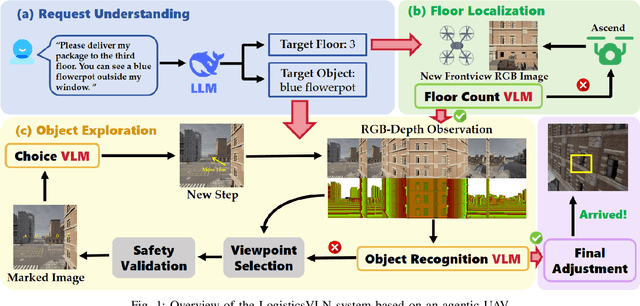
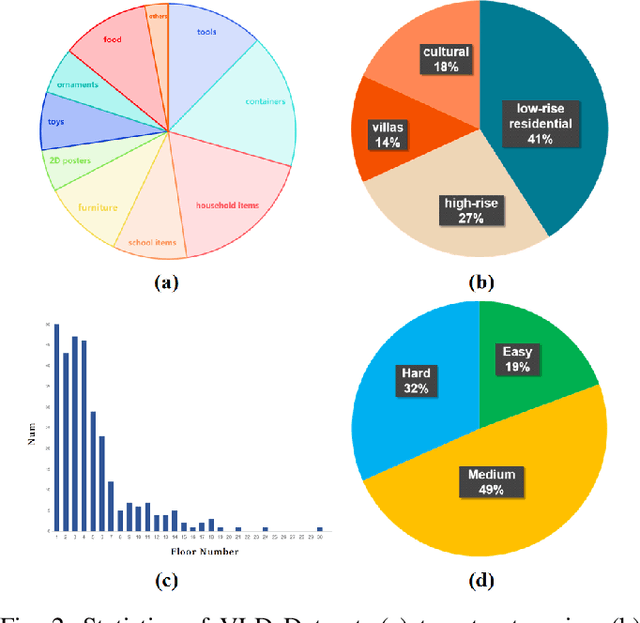
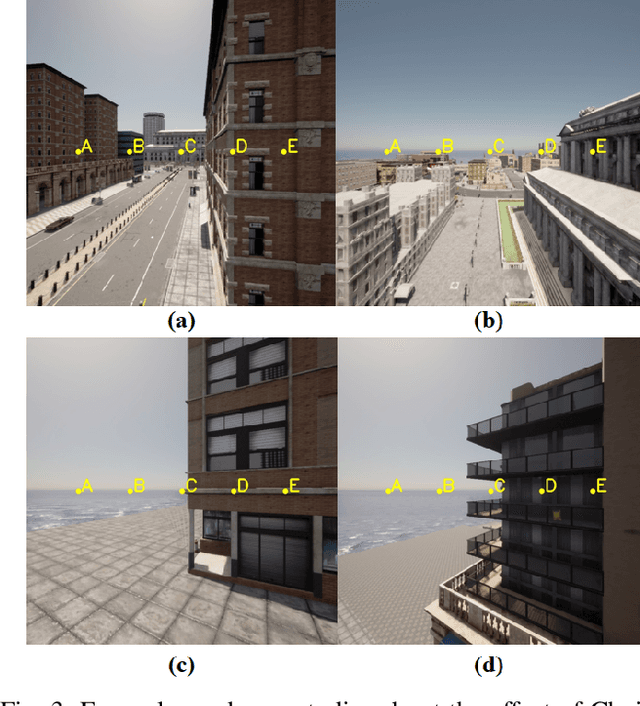

Abstract:The growing demand for intelligent logistics, particularly fine-grained terminal delivery, underscores the need for autonomous UAV (Unmanned Aerial Vehicle)-based delivery systems. However, most existing last-mile delivery studies rely on ground robots, while current UAV-based Vision-Language Navigation (VLN) tasks primarily focus on coarse-grained, long-range goals, making them unsuitable for precise terminal delivery. To bridge this gap, we propose LogisticsVLN, a scalable aerial delivery system built on multimodal large language models (MLLMs) for autonomous terminal delivery. LogisticsVLN integrates lightweight Large Language Models (LLMs) and Visual-Language Models (VLMs) in a modular pipeline for request understanding, floor localization, object detection, and action-decision making. To support research and evaluation in this new setting, we construct the Vision-Language Delivery (VLD) dataset within the CARLA simulator. Experimental results on the VLD dataset showcase the feasibility of the LogisticsVLN system. In addition, we conduct subtask-level evaluations of each module of our system, offering valuable insights for improving the robustness and real-world deployment of foundation model-based vision-language delivery systems.
CoordField: Coordination Field for Agentic UAV Task Allocation In Low-altitude Urban Scenarios
Apr 30, 2025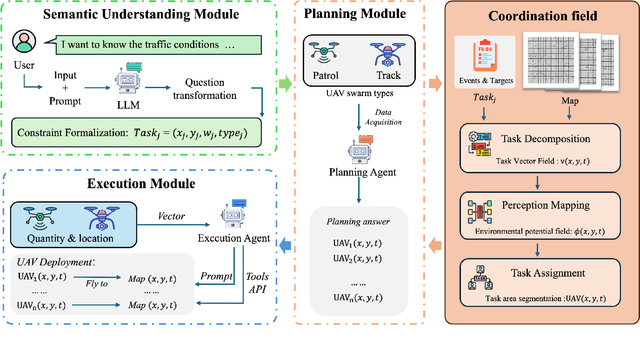
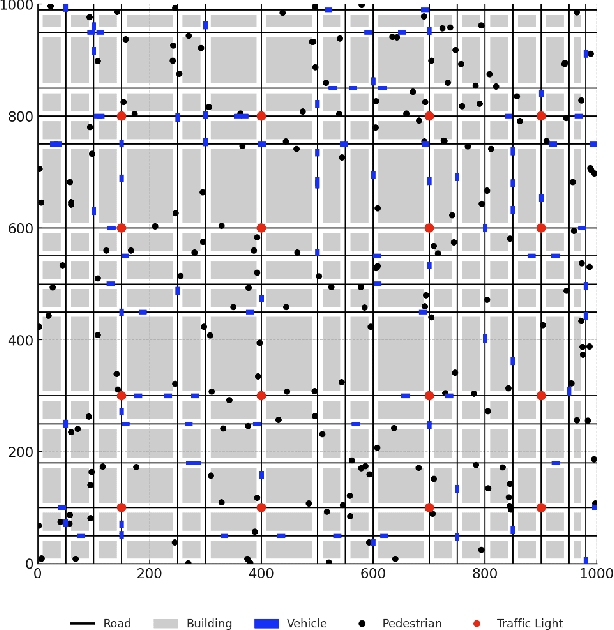
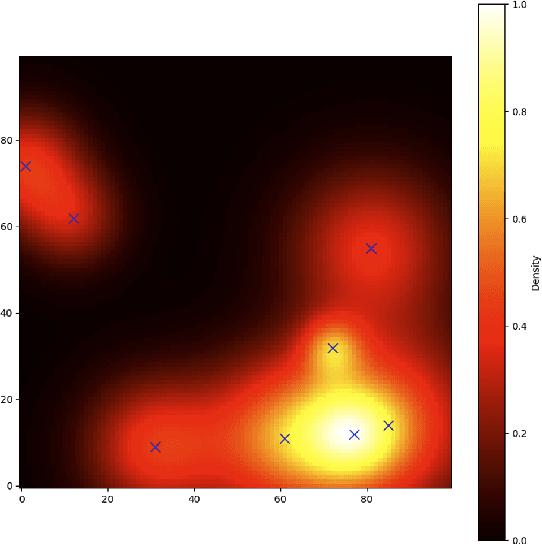
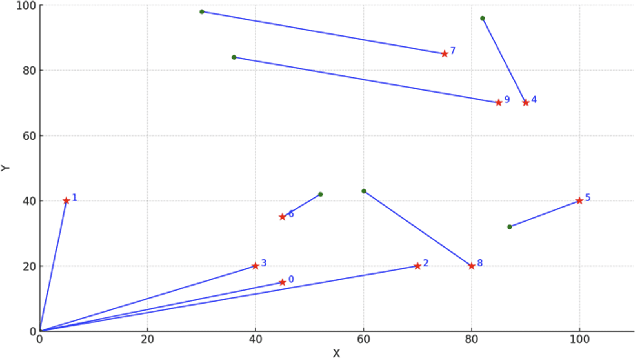
Abstract:With the increasing demand for heterogeneous Unmanned Aerial Vehicle (UAV) swarms to perform complex tasks in urban environments, system design now faces major challenges, including efficient semantic understanding, flexible task planning, and the ability to dynamically adjust coordination strategies in response to evolving environmental conditions and continuously changing task requirements. To address the limitations of existing approaches, this paper proposes coordination field agentic system for coordinating heterogeneous UAV swarms in complex urban scenarios. In this system, large language models (LLMs) is responsible for interpreting high-level human instructions and converting them into executable commands for the UAV swarms, such as patrol and target tracking. Subsequently, a Coordination field mechanism is proposed to guide UAV motion and task selection, enabling decentralized and adaptive allocation of emergent tasks. A total of 50 rounds of comparative testing were conducted across different models in a 2D simulation space to evaluate their performance. Experimental results demonstrate that the proposed system achieves superior performance in terms of task coverage, response time, and adaptability to dynamic changes.
AirVista-II: An Agentic System for Embodied UAVs Toward Dynamic Scene Semantic Understanding
Apr 13, 2025Abstract:Unmanned Aerial Vehicles (UAVs) are increasingly important in dynamic environments such as logistics transportation and disaster response. However, current tasks often rely on human operators to monitor aerial videos and make operational decisions. This mode of human-machine collaboration suffers from significant limitations in efficiency and adaptability. In this paper, we present AirVista-II -- an end-to-end agentic system for embodied UAVs, designed to enable general-purpose semantic understanding and reasoning in dynamic scenes. The system integrates agent-based task identification and scheduling, multimodal perception mechanisms, and differentiated keyframe extraction strategies tailored for various temporal scenarios, enabling the efficient capture of critical scene information. Experimental results demonstrate that the proposed system achieves high-quality semantic understanding across diverse UAV-based dynamic scenarios under a zero-shot setting.
Offline Reinforcement Learning with Discrete Diffusion Skills
Mar 26, 2025
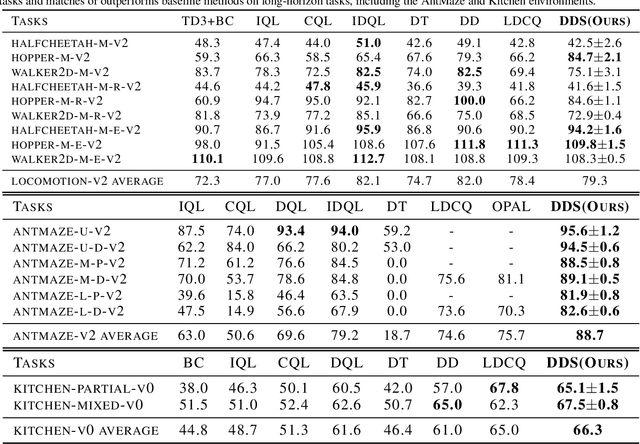
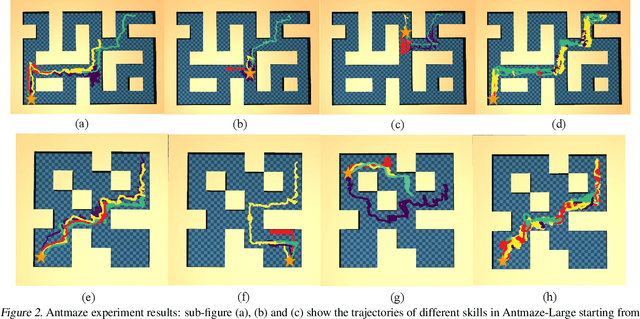

Abstract:Skills have been introduced to offline reinforcement learning (RL) as temporal abstractions to tackle complex, long-horizon tasks, promoting consistent behavior and enabling meaningful exploration. While skills in offline RL are predominantly modeled within a continuous latent space, the potential of discrete skill spaces remains largely underexplored. In this paper, we propose a compact discrete skill space for offline RL tasks supported by state-of-the-art transformer-based encoder and diffusion-based decoder. Coupled with a high-level policy trained via offline RL techniques, our method establishes a hierarchical RL framework where the trained diffusion decoder plays a pivotal role. Empirical evaluations show that the proposed algorithm, Discrete Diffusion Skill (DDS), is a powerful offline RL method. DDS performs competitively on Locomotion and Kitchen tasks and excels on long-horizon tasks, achieving at least a 12 percent improvement on AntMaze-v2 benchmarks compared to existing offline RL approaches. Furthermore, DDS offers improved interpretability, training stability, and online exploration compared to previous skill-based methods.
UAVs Meet LLMs: Overviews and Perspectives Toward Agentic Low-Altitude Mobility
Jan 04, 2025Abstract:Low-altitude mobility, exemplified by unmanned aerial vehicles (UAVs), has introduced transformative advancements across various domains, like transportation, logistics, and agriculture. Leveraging flexible perspectives and rapid maneuverability, UAVs extend traditional systems' perception and action capabilities, garnering widespread attention from academia and industry. However, current UAV operations primarily depend on human control, with only limited autonomy in simple scenarios, and lack the intelligence and adaptability needed for more complex environments and tasks. The emergence of large language models (LLMs) demonstrates remarkable problem-solving and generalization capabilities, offering a promising pathway for advancing UAV intelligence. This paper explores the integration of LLMs and UAVs, beginning with an overview of UAV systems' fundamental components and functionalities, followed by an overview of the state-of-the-art in LLM technology. Subsequently, it systematically highlights the multimodal data resources available for UAVs, which provide critical support for training and evaluation. Furthermore, it categorizes and analyzes key tasks and application scenarios where UAVs and LLMs converge. Finally, a reference roadmap towards agentic UAVs is proposed, aiming to enable UAVs to achieve agentic intelligence through autonomous perception, memory, reasoning, and tool utilization. Related resources are available at https://github.com/Hub-Tian/UAVs_Meet_LLMs.
MambaOcc: Visual State Space Model for BEV-based Occupancy Prediction with Local Adaptive Reordering
Aug 21, 2024Abstract:Occupancy prediction has attracted intensive attention and shown great superiority in the development of autonomous driving systems. The fine-grained environmental representation brought by occupancy prediction in terms of both geometry and semantic information has facilitated the general perception and safe planning under open scenarios. However, it also brings high computation costs and heavy parameters in existing works that utilize voxel-based 3d dense representation and Transformer-based quadratic attention. To address these challenges, in this paper, we propose a Mamba-based occupancy prediction method (MambaOcc) adopting BEV features to ease the burden of 3D scenario representation, and linear Mamba-style attention to achieve efficient long-range perception. Besides, to address the sensitivity of Mamba to sequence order, we propose a local adaptive reordering (LAR) mechanism with deformable convolution and design a hybrid BEV encoder comprised of convolution layers and Mamba. Extensive experiments on the Occ3D-nuScenes dataset demonstrate that MambaOcc achieves state-of-the-art performance in terms of both accuracy and computational efficiency. For example, compared to FlashOcc, MambaOcc delivers superior results while reducing the number of parameters by 42\% and computational costs by 39\%. Code will be available at https://github.com/Hub-Tian/MambaOcc.
Pillar in Pillar: Multi-Scale and Dynamic Feature Extraction for 3D Object Detection in Point Clouds
Dec 11, 2019



Abstract:Sparsity and varied density are two of the main obstacles for 3D detection networks with point clouds. In this paper, we present a multi-scale voxelization method and a decomposable dynamic convolution to solve them. We consider the misalignment problem between voxel representation with different scales and present a center-aligned voxelization strategy. Instead of separating points into individual groups, we use an overlapped partition mechanism to avoid the perception deficiency of edge points in each voxel. Based on this multi-scale voxelization, we are able to build an effective fusion network by one-iteration top-down forward. To handle the variation of density in point cloud data, we propose a decomposable dynamic convolutional layer that considers the shared and dynamic components when applying convolutional filters at different positions of feature maps. By modeling bases in the kernel space, the number of parameters for generating dynamic filters is greatly reduced. With a self-learning network, we can apply dynamic convolutions to input features and deal with the variation in the feature space. We conduct experiments with our PiPNet on KITTI dataset and achieve better results than other voxelization-based methods on 3D detection task.
 Add to Chrome
Add to Chrome Add to Firefox
Add to Firefox Add to Edge
Add to Edge